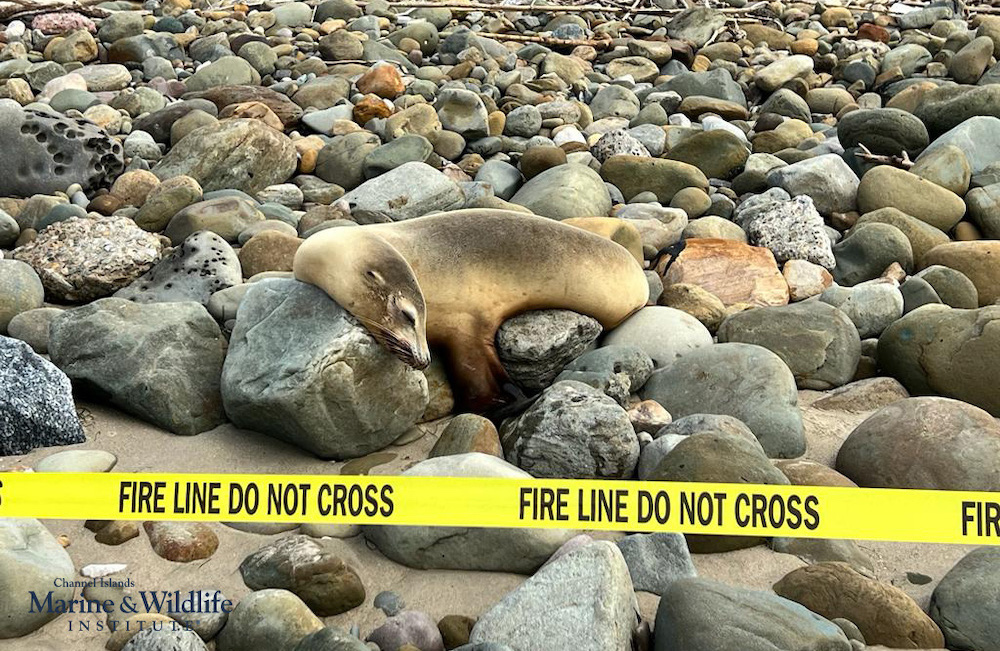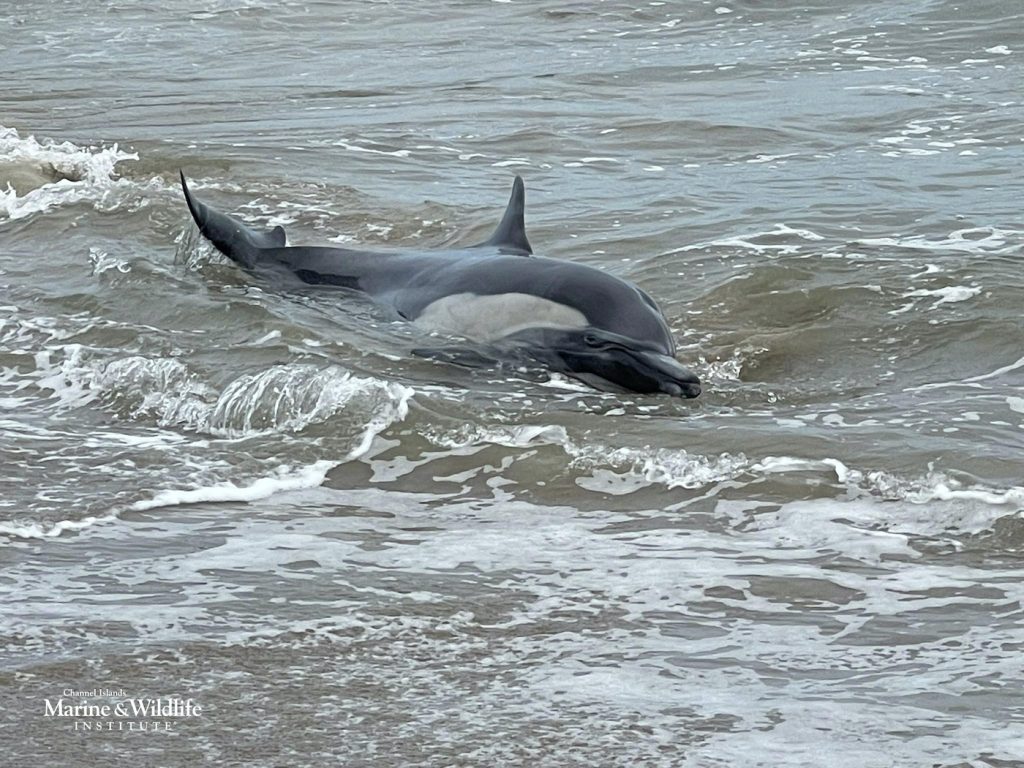Harmful Algae Blooms

Domoic Acid Crisis Drives Sea Lion and Dolphin Deaths: Local Organization Rescues Record-Breaking 85 Sea Lions in June
In the early hours of a Saturday morning on Butterfly Beach, a small crowd gathers. The focus of their attention is brown, unmoving, and looks to be a large rock or piece of driftwood. But closer inspection reveals flippers, whiskers, snout, and a tail. It’s the daily casualty in the domoic acid crisis that began June 8: a female sea lion about three years of age. Nearby, a sea lion yearling lies closer to Channel Drive, his head slung over the rocks dotting the shore. On Miramar Beach there’s a dead dolphin and another female sea lion having active seizures; at Fernald Point a sick sea lion puppy and a dead adult sea lion, face half buried in the sand.
A mix of locals and tourists stare in disbelief with varying levels of distress rising among them. All had come to the beach for a walk in the sun now that the months-long June gloom had cleared, and they’ve been met instead with the collateral damage of an ocean and atmosphere that’s out of balance. “I’ve never seen anything like this, and I’ve lived here 40 years,” notes local resident Barbara Keyani, “It’s devastating to watch.”
Harmful Algae Blooms, a.k.a. ‘Red Tides’
Domoic acid is a naturally-occurring amino acid from an algae called pseudo-nitzschia, and it can act as a neurotoxin in certain animals. The shellfish and filter fish that feed on it might not be affected, but depending on where it hits in the food web and at what time, it can cause issues higher up the food chain, striking birds and marine mammals.
This particular harmful algae bloom, which began at the end of May, has hit dolphins and sea lions especially hard. Pregnant and nursing female sea lions are especially impacted due to the large amount of fish they eat to produce milk and sustain a pregnancy. More than 70,000 female sea lions come to the Channel Islands for pupping season every year, which peaks June 15, compounding the number of deaths.
The reasons for harmful algae blooms (HABs), as they’re known, are wide ranging and multi factorial. The two primary drivers of ocean imbalance are the changing pH balance and across the board warming of the waters themselves. Then there are natural ocean events like an underwater volcano, or ocean-wide shifts like El Niño, which officially arrived this June according to the National Oceanic and Atmospheric Administration (NOAA). Add to this mix excess nutrients from human wastewater and agricultural runoff and ocean heat waves, which are increasing around the world. Cold water upwelling, normally a natural and beneficial ocean process, can exacerbate the conditions for HABs to thrive and bloom as well. Monica Thukral, a PhD student at UC San Diego who studies pseudo-nitzschia,describes it this way, “Just like there are wildfires that are natural burns, when you take the ecosystem out of balance, the fires happen more frequently and abundantly. It’s the same with these harmful
algae blooms.”
On the Frontlines
The Channel Islands Marine & Wildlife Institute (CIMWI) is the local organization that focuses on rescue and rehabilitation of marine mammals in Santa Barbara and the Channel Islands – a geographic area spanning 155 miles. Founded by Ruth and Sam Dover, they field stranded animal call reports from the public, monitoring any marine mammals sickened by the domoic acid, triaging and determining which ones should be brought in for treatment. When there isn’t an algae bloom or unusual mortality event going on, they typically rehab seals and sea lions with injuries or malnourishment, and they’re authorized to respond to sea turtles, whales, dolphins, and porpoises, who they triage and send to specialists for care.
Like many of the organizations up and down the California coast dedicated to helping marine mammals, they perform what is essentially a public service for the community complete with a hotline to call when a beachgoer finds a stranded animal. And while the perception is that they work closely with the city and county, CIMWI does not receive any public funding at the local level.

NOAA offers modest yearly grants, and the State of California offers the biggest annual chunk of public funding. The rest of their operating budget comes from private donations. Sam Dover, the medical director and former SeaWorld Marine Mammal specialist, notes, “Our fish bill to feed the sea lions we took in was $30,000 alone in June. Our electricity and water bills spiked. We had three volunteers just answering calls and voicemails day and night all of June, and our team is just exhausted. Then we have the public asking us why we’re not there for each animal they call in. It’s heartbreaking for all of us and we wish we could do more.”
On a recent rescue mission with CIMWI at Butterfly Beach, there’s a large adult female actively seizing, and another two-year-old male is nearby, flopped up on the rocks. Ken, a CIMWI volunteer, is assessing the animals and calling them in to headquarters where their medical director decides what type of intervention if any to recommend. After posting informational signs about domoic acid and cordoning off an area around the sea lions to protect them from passersby, he moves on to Fernald Point. There, a volunteer who has come down from the Marine Mammal Center in Sausalito to help during the crisis has identified a one-year-old male, and has authorization to bring it into the hospital.
The volunteers expertly maneuver the sea lion into a kennel using a net, and this writer is recruited to hold the kennel so they can load him in. Normally a rescue like this would have four people or more, but with the volume of calls CIMWI is getting during this unprecedented crisis, even with volunteers from Shedd, Vancouver, and Jenkinson’s aquariums, SeaWorld, and the Marine Mammal Center, they are shorthanded. Once settled in his crate, the young male is curious and alert. He’s transported up to the hospital on Ken’s truck and assigned a number so that staff can track his progress.
At CIMWI’s hospital and rehab center, each animal is assessed, given any medicine needed and fluids to try and flush the domoic acid from their system. Anywhere from 10 to 12 volunteers and one full-time staff manager, who manages daily operations, monitor and care for the mammals daily, track their progress, and report back to Dover. They also send valuable data to NOAA for research and tracking.
The facility is the Vista Del Mar Union School and grounds donated by the Hollister family in 2011, complete with a 1920s auditorium and several outbuildings. Two small pools with specially calibrated filtration and 10 kennels as well as surgical suite, and a “fish kitchen” round out the facility.
On a recent tour, Dover points out all the improvements he’d like to make so that they can expand their efforts and handle the increasing levels of domoic acid crises happening. “We could use more pools, and it would be nice to make the auditorium into a place where we could have events or members of the public to learn about the ocean and the work we do here.” The Dovers have both foregone salaries for many years, which worked when there weren’t as many crisis events happening, but as the ocean warms, they’ll need more resources to meet the needs of the community.
Looking Ahead
While domoic acid surges causes are myriad, many scientists point to excess nutrients in the ocean like nitrogen and phosphorous as tipping things over the edge. These typically come from human wastewater and agricultural runoff, which can increase in years with heavy rains. Raphael Kudela, a professor in Ocean Sciences at UC Santa Cruz, notes, “If you got rid of the human addition of nutrients into the oceans from wastewater, these domoic acid crisis events would lessen.”
Woody Barrett, president of the Montecito Sanitary District, says that they’ve been actively looking at the human wastewater over the last few years and commissioned two studies to see how wastewater could be recycled and used for irrigation to reduce input into the ocean. They plan to take action on this soon. “We’re very active on this and have been for two years – we’re also looking to Sacramento as well, as legislation around water recycling and wastewater treatment has been percolating there for a while.”
Local resident Mark Greise, a 30-year resident of Santa Barbara who regularly fishes, dives, and surfs these waters, says in his years of living here, while he’s seen previous red tides he’s never seen one where dead dolphins are washing up on shore. “We’re such a rich county in the state, we should be able to put together resources to save our ocean life. If we don’t, we will all suffer.”





